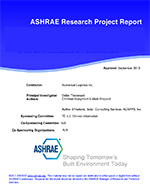
RP-1083 — Chemical Off-Gassing from Indoor Swimming Pools
- Comments Off on RP-1083 — Chemical Off-Gassing from Indoor Swimming Pools
- ASHRAE
With little of no knowledge of pool water chemistry and air flow properties in a structure, it is virtually impossible to design a ventilation system that addresses the pollutants generated in an indoor pool environment. This research is devoted to chlorine-based pool water treatment, filtration and chemistry, and the physical properties of an indoor swimming pool facility in order to provide the Mechanical System Designer with specification guidelines for improved air quality.
The chemical composition of both pool water content and air vapor content of an indoor test swimming pool are assessed. The salient compound of interest is nitrogen trichloride (NCl3), which is also known as trichloramine (TCA). Along with TCA, trihalomethanes (THMs) are formed, which are dependent upon pool water chemistry as well.
Pool water composition is determined using standard analytical methods, all specific in chemistry identificaiton and quantity. Aqueous derived effluent from the mechanical dehumidification (MDH) system is analyzed for chloramines and pH using commercially available products utilizing standard water chemistry and the spectrometric method. Pool vapor content and composition are determined by gas chromatography using standard NIOSH and OSHA analytical methods and includes preliminary trichloramine measurement obtained using published methods.
The physical properties of the indoor test pool take into account as much as possible the mechanical and dimensional attributes of design of a typical enclosure. This includes intake, return air and exhaust vent positioning and air volume. Pool vapor composition sampling is taken from above the pool surface, as well as from the exhaust air and return air vents to the MDH.
A walk-through evaluation of a number of local pool enclosures indicated all the enclosures follow the pattern of current thinking using re-circulated air, outside air exchange and varying exhaust air flow rates. Based on observation within the indoor test pool enclosure, this research confirms and highlights that the vapor (gas) that causes the most irritaiont is trichloramine (TCA or nitrogen trichloride). Being heavier than air, TCA has properties that shoud be handled with known air distribution methods of elimination as defined by ASHRAE guidelines. When used in conjunction with deck (ground) level ventilation, low exhaust air movement at ASHRAE’s current ventilation rate (0.5 cfm/ft2) can be successful in maintaining low levels of TCA within the indoor space.
Units: Dual
Product Details
- Published:
- 2008
- Number of Pages:
- 39
- File Size:
- 1 file , 3.6 MB
- Product Code(s):
- D-RP-1083

